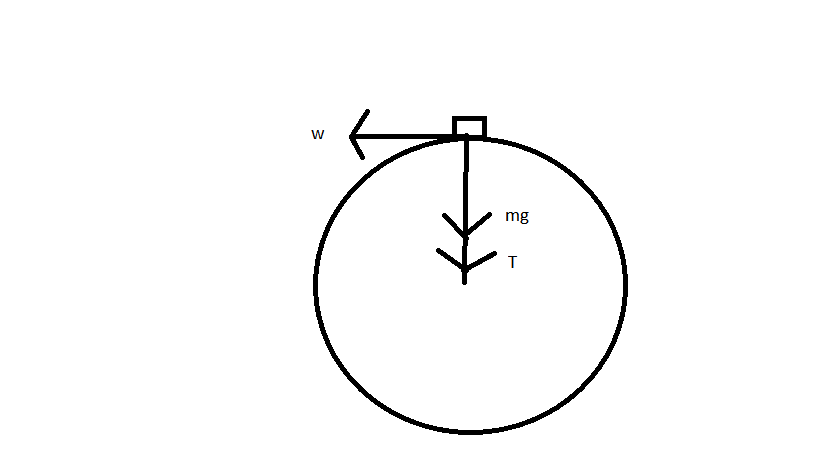
A body of mass $0.4kg$ is whirled in a vertical circle making $2\,rev/s$. If the radius of the circle is $2m$ ,then the tension in the string when the body is at the top of the circle is
A.$41.56N$
B.$89086N$
C.$109.86N$
D.$122.33N$
Answer
556.8k+ views
Hint:The question is to be solved using concepts of motion in a vertical circle.it is an example of non-uniform circular motion.
The force responsible for making a body move in a circular motion is centripetal force.it always acts towards the centre of the circle in which body moves.
In our case, when the body will be the top most point, the tension in the string and the weight will provide the necessary centripetal force. We can analyse it by the free body diagram of the body at the top most point.

Complete answer:
At the top most point from the figure it is visible that tension and weight both are acting downwards that is towards the centre and are providing necessary centripetal force for the body to move.
The velocity of the body is perpendicular to the forces acting on the body
From the diagram,
Centripetal force in terms of angular velocity $w$, mass $m$ and radius $r$ is defined as $m\times {{w}^{2}}\times r..........\left( 1 \right)$
Necessary centripetal force=weight + tension
Given values $w=2\pi f$ where f is frequency
$f=2rev/s$
$m=0.4kg$
$r=2m$
Putting the values in the equation $m\times {{w}^{2}}\times r$
$\Rightarrow 0.4\times {{\left( 2\times 3.14\times 2 \right)}^{2}}\times 2=T+0.4\times 10$
$\Rightarrow T=\left( 126.20-4 \right)N$
$T=122.20N$
Hence the correct and nearest option is D.
NoteE:
A centrifugal force is the outward inertial force on an object moving along a curved path. An object will move in a curved path, provided a centripetal force prevents it from moving in a straight line. Newton's Third Law or Action-Reaction Law states that for every applied force, there is an equal and opposite force.
This means centrifugal force is a fictitious force and equal and opposite to centripetal force.
Critical velocity is the velocity given to a particle for it to complete a vertical circle.
The force responsible for making a body move in a circular motion is centripetal force.it always acts towards the centre of the circle in which body moves.
In our case, when the body will be the top most point, the tension in the string and the weight will provide the necessary centripetal force. We can analyse it by the free body diagram of the body at the top most point.

Complete answer:
At the top most point from the figure it is visible that tension and weight both are acting downwards that is towards the centre and are providing necessary centripetal force for the body to move.
The velocity of the body is perpendicular to the forces acting on the body
From the diagram,
Centripetal force in terms of angular velocity $w$, mass $m$ and radius $r$ is defined as $m\times {{w}^{2}}\times r..........\left( 1 \right)$
Necessary centripetal force=weight + tension
Given values $w=2\pi f$ where f is frequency
$f=2rev/s$
$m=0.4kg$
$r=2m$
Putting the values in the equation $m\times {{w}^{2}}\times r$
$\Rightarrow 0.4\times {{\left( 2\times 3.14\times 2 \right)}^{2}}\times 2=T+0.4\times 10$
$\Rightarrow T=\left( 126.20-4 \right)N$
$T=122.20N$
Hence the correct and nearest option is D.
NoteE:
A centrifugal force is the outward inertial force on an object moving along a curved path. An object will move in a curved path, provided a centripetal force prevents it from moving in a straight line. Newton's Third Law or Action-Reaction Law states that for every applied force, there is an equal and opposite force.
This means centrifugal force is a fictitious force and equal and opposite to centripetal force.
Critical velocity is the velocity given to a particle for it to complete a vertical circle.
Recently Updated Pages
Master Class 11 Economics: Engaging Questions & Answers for Success

Master Class 11 English: Engaging Questions & Answers for Success

Master Class 11 Social Science: Engaging Questions & Answers for Success

Master Class 11 Biology: Engaging Questions & Answers for Success

Class 11 Question and Answer - Your Ultimate Solutions Guide

Master Class 11 Business Studies: Engaging Questions & Answers for Success

Trending doubts
10 examples of friction in our daily life

One Metric ton is equal to kg A 10000 B 1000 C 100 class 11 physics CBSE

Difference Between Prokaryotic Cells and Eukaryotic Cells

1 Quintal is equal to a 110 kg b 10 kg c 100kg d 1000 class 11 physics CBSE

State the laws of reflection of light

Explain zero factorial class 11 maths CBSE




